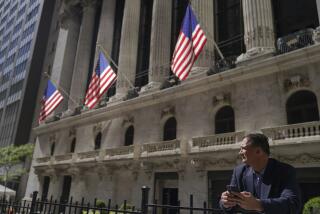Stocks falter after their biggest week since 1974

- Share via
Stocks on Wall Street fell Monday, erasing some of the market’s big gains from last week, as investors braced for a sobering first look at how the coronavirus pandemic has hurt company earnings.
The Standard & Poor’s 500 index fell 1% after cutting its early losses by more than half toward the end of the day. The benchmark index surged 12% last week, its biggest weekly gain since 1974.
The pullback followed news over the weekend that OPEC, Russia and other oil-producing nations have agreed to cut output — an effort to stop crude prices from sliding so much after the coronavirus outbreak caused demand for oil to collapse.
Financial, industrial and healthcare stocks took some of the biggest hits Monday. Amazon and a few other retailers were bright spots. Traders continued to watch for more signs that the coronavirus outbreak may be leveling off and what that could mean for the prospects of reopening the economy.
Cautious optimism that the outbreak has begun to plateau in some of the worst-hit areas and another big infusion of economic support by the Federal Reserve helped spur last week’s big rally. This week, stocks could be in for more volatility as companies report first-quarter results, though analysts will be focused primarily on what management teams have to say about what the rest of the year looks like.
Details may be hard to come by, as many companies have ceased giving earnings forecasts because of the uncertainty over when government officials will determine it’s safe to roll back the social distancing and stay-at-home mandates that have all but ground the economy to a halt.
“The companies don’t know what demand is going to be over the next three months or over the next six months,” said Willie Delwiche, investment strategist at Baird.
The S&P 500 index fell 28.19 points to 2,761.63. The Dow Jones industrial average fell 328.60 points, or 1.4%, to 23,390.77. The Nasdaq composite reversed an early slide and ended with a gain of 38.85 points, or 0.5%, at 8,192.42. The Russell 2000 index of smaller-company stocks fell 34.68 points, or 2.8%, to 1,212.04.
European markets were closed for a holiday. Asian markets mostly lost ground.
Bond prices fell. The yield on the 10-year Treasury dropped to 0.75% from 0.72%.
Several major banks, including JPMorgan Chase, Wells Fargo and Bank of America, as well as big companies including UnitedHealth Group, Johnson & Johnson and Rite Aid, are on deck to report results this week.
Analysts predict that first-quarter earnings for all the companies in the S&P 500 will be down 9% from a year earlier, according to FactSet. That would be the biggest annual decline in earnings for the index since the third quarter of 2009, when earnings slumped nearly 16%.
“Our view is it’s one big write-off year,” said Keith Lerner, chief market strategist at SunTrust Advisory Services. “The market is going to start thinking more about 2021, 2022. On the other side of this, what does that business look like?”
The closure of businesses and mandates for people to stay home have forced a record number of Americans out of work and raised the possibility that many businesses could end up bankrupt. That has many investors anticipating what may be the worst recession since the Great Depression.
Investors have been focused on the trajectory of the coronavirus for clues as to how pronounced the economic fallout will be. Despite some positive signs — the daily death toll in New York fell below 700 on Sunday for the first time in a week — the overall data indicate that the number of new cases continues to increase.
There are more than 1.9 million confirmed cases worldwide, led by the United States with more than 577,000, according to a tally by Johns Hopkins University.
Traders are trying to gauge when shutdowns in many countries might ease. Comments by Dr. Anthony Fauci, the top infectious disease expert in the U.S., have raised hopes. He has said some parts of the country might be able to reopen as early as next month, while warning that much remains uncertain.
China has begun, cautiously, to reopen activity in regions such as Wuhan and surrounding Hubei province that were shut down during the worst of its outbreak.
After last week’s big upward jolt, stocks are probably moving into a trading range reflecting a tug of war between investors’ hopes for a recovery and concerns about the extent of the damage to the economy. Quick actions by the Fed and the $2-trillion economic aid package from the government have eased some of investors’ concerns.
That optimism has helped push the S&P 500 up 6.9% this month, though it’s still down 18.4% from the record high it reached Feb. 19.
Oil prices got a brief boost following the decision by OPEC and other oil producers over the weekend to cut production by nearly 10 million barrels a day, or a tenth of global supply, beginning May 1.
Analysts said the cuts were not enough to make up for the void in demand caused by the coronavirus-induced shutdowns of business and travel. But the deal at least helped resolve a price war that took U.S. crude to near $20 per barrel, pummeling U.S. oil and gas producers.
U.S. benchmark crude jumped more than $1 early Monday but then lost ground. It ended down 35 cents at $22.41 a barrel. Brent, the international standard, rose 26 cents to $31.74 a barrel.
More to Read
Inside the business of entertainment
The Wide Shot brings you news, analysis and insights on everything from streaming wars to production — and what it all means for the future.
You may occasionally receive promotional content from the Los Angeles Times.










